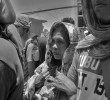Comparatively, affected areas during Sendong were limited to vicinities within the riverbanks. But during Pablo, a much wider range has been damaged.
By BEVERLY ANN S. MUSNI, YR.
Davao Today
When asked to write about the Sendong and Pablo typhoons, having experienced both catastrophes on different levels, my mind went blank. There are no words to describe the unfathomable horror that descended upon those who have witnessed the tragedy. Sights and sounds resurfaced, like a horror film. Wails of anguish, sobs of uncontrollable sadness, dazed and glazed looks in the victims’ eyes, muddied dead bodies lying in the sidewalks, the living even more soiled and filthy.
And yes, like a horror film, no matter how much you close your eyes from seeing the devastation, you cannot help but see death smiling at them. No matter how much you cover your ears from their wails, one can hear desperation, of hopelessness being sucked out from them.
When Sendong ravaged Cagayan de Oro last December 17, 2011, we were all taken by surprise. No one really believed that we could suffer that much damage. Our city was way out of the “typhoon zone.” After all, the Kagay-anons believed, we were being protected by the Agusan and Kitanglad mountain ranges.
But there would always be an exception to the rule.
As bodies after bodies were found, reality hit like a freight train ramming us all. News about Sendong was being broadcast in radio stations, raising signal number two all over Northern Mindanao. But nobody really did care as everyone was busy getting ready for the holiday parties. As text messages and calls from friends and relatives came in rapid succession late in the evening about the people’s situation, it was getting out of hand. And soon enough, news came that friends and relatives have perished. It was dark, hellish and indescribable.
I volunteered alongside Panday Bulig, Inc., a non-government organization, a relief and rehabilitation center which efficiently and immediately set-up relief, clean-up and rebuilding operations to help various and numerous hard-hit areas in Cagayan de Oro like the villages of Consolacion, Macasandig, Macabalan and Carmen; and also in Iligan City. Thousands have perished and went missing during Sendong. Yet thousands more have extended help and volunteered for the people of Cagayan de Oro and Iligan. It was amazing.
Last December 4, 2012, Typhoon Bopha barreled through Mindanao, hitting Northern Mindanao again. I was in Bukidnon that time. And the province which is hours away from my hometown hardly held on to the ground as powerful winds gusting at 260 kilometers per hour have flattened landscapes, uprooted trees and erased towns from the Mindanao map. It was the strongest tropical cyclone to hit the island.
It was déjà vu. A recurring nightmare. Why is this happening again? The question hounds us no end.
Comparatively, affected areas during Sendong were limited to vicinities within the riverbanks. But during Pablo, a much wider range has been damaged. During Sendong, reasons for the tragedy have been enumerated. Damage was attributed mainly because of forest denudation of the Mt. Kitanglad and the Mt. Kalatungan watersheds. Vast expansions of pineapple and banana plantations at the foot of Mt. Kitanglad had also been cited as one of the main reasons. Large-scale mining operations have also contributed as the direct cause of the tragedy. And the proof was right before our eyes: mining equipment and huge trunks of trees found downstream and along the riverbanks in the aftermath.
With Pablo, one can attribute such disaster to climate change, an issue which continuously brought flashfloods and storms all over the world, an issue which continue to hound the countries for a solution through the years. And what did the government make of this issue right now?
Though high-tech machineries currently acquired by Pag-asa (the Philippine Atmospheric, Geophysical and Astronomical Services Administration) have correctly predicted the intensity and warned the people accordingly of typhoon Pablo, we have apparently underestimated its power. We were not ready for such massive blow. We were not ready for its power.
While the people clamor for climate justice, the government still lacks the initiative and the will to strongly protect the environment which would and could prevent such catastrophes. Mining conglomerates continue to amass wealth, apparently finding ways to acquire permits from the DENR (Department of Environment and Natural Resources) and from various tribes, either through threats and human rights violations directed against tribal leaders and their members.
The Forestry Code visibly has loopholes in its provisions which do not provide a clear demarcation of boundaries of watersheds. Such resulted to the dwindling of watersheds because of the encroachment of logging, mining and agri-business plantations which were marked as “protected areas.”
Environmental laws and ordinances also provide no further protection, rather contradicting each other’s policies. For example, Circular 2005-05 by former environment secretary Michael Defensor adopted the United Nations Framework Convention on Climate Changewhich declared that “a forest is an area of land with a minimum size of 0.5 to 1 hectare, with a tree cover of more than 10-30%, with trees in the potential to reach a height of 2-5 meters at maturity in situ.” In effect, this declares the banana plantations as “forest” and is an invitation for more plantations to be built in Mt. Kitanglad in Bukidnon, for example, and other “protected areas.”
So what do we make from it all?
In the provinces of Compostela Valley and Davao Oriental in Southern Mindanao, mining, logging and agri-business corporations also abound further disintegrating the environment and providing little, if not none at all, protection from the now disaster-struck areas.
This is a larger-than-life challenge. I don’t know if the Aquino government can manage this. But on a positive note, the gargantuan challenge of the Reproductive Health Bill was surpassed. Maybe a bit of positive thinking can do for this moment when it comes to the environmental laws of our land. It is a long shot. But it will do for now. After all, it is a new year. After the twin disasters I have seen and experienced, a little bit of hope will do. For now, it will do.
Beverly Ann S. Musni, Yr. is a free spirit. She is a wanderlust, a dreamer and a frustrated rock star who dreams of travelling the world one day. She is a world peace advocate.

![[STANDPOINT] Illegal drugs and the NIMBY mindset](https://davaotoday.com/wp-content/uploads/2016/09/Mags-Maglana_UPMIN-Sept.-20-110x100.jpg)








